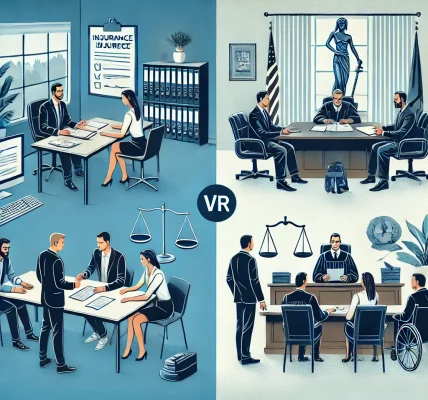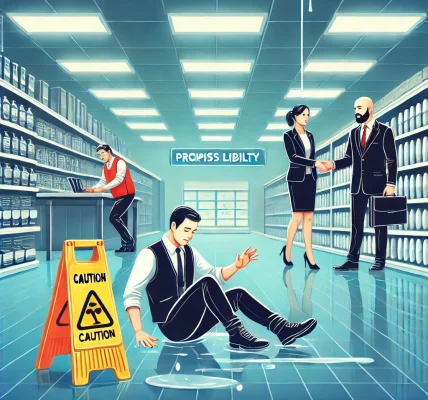Introduction
Negligence is the foundation of most personal injury cases. When an individual or entity fails to exercise reasonable care, causing harm to another person, they can be held legally responsible. Understanding how negligence applies to personal injury law is essential for anyone seeking compensation after an accident.
In this comprehensive guide, we will break down the concept of negligence, its elements, how it is proven in court, and how it impacts personal injury claims.
1. What Is Negligence in Personal Injury Law?
Negligence refers to a failure to exercise the level of care that a reasonable person would under similar circumstances. In personal injury cases, proving negligence is crucial in holding the responsible party liable for damages.
Examples of Negligence in Personal Injury Cases
- A driver texting while driving and causing an accident.
- A property owner failing to fix a broken staircase, leading to a slip-and-fall accident.
- A doctor misdiagnosing a patient due to inattention.
- A manufacturer producing a defective product that causes injuries.
2. The Four Key Elements of Negligence
To establish negligence in a personal injury case, the plaintiff (injured party) must prove the following four elements:
1. Duty of Care
The defendant (responsible party) must have owed a legal duty of care to the plaintiff. A duty of care exists in various situations, such as:
- Drivers have a duty to obey traffic laws and drive safely.
- Doctors have a duty to provide proper medical treatment.
- Property owners must maintain safe premises for visitors.
2. Breach of Duty
The plaintiff must prove that the defendant breached their duty of care by acting negligently or failing to act when necessary. Examples include:
- Running a red light and causing a collision.
- Failing to clean up a hazardous spill in a grocery store.
- Prescribing the wrong medication to a patient.
3. Causation (Link Between Breach and Injury)
There must be a direct link between the defendant’s actions (or inaction) and the plaintiff’s injuries. Courts examine two types of causation:
- Actual Cause (Cause in Fact) – Would the injury have occurred without the defendant’s actions?
- Proximate Cause – Was the injury a foreseeable result of the defendant’s conduct?
For example, if a driver runs a red light and crashes into another vehicle, causing a back injury, their negligence is the proximate cause of the injury.
4. Damages (Actual Harm Suffered)
The plaintiff must demonstrate that they suffered actual damages, such as:
- Medical expenses
- Lost wages
- Pain and suffering
- Property damage
Without damages, even if negligence occurred, there is no valid personal injury claim.
3. Comparative vs. Contributory Negligence
Negligence laws vary by state, and the degree of fault can impact compensation. The two main types of negligence rules are:
Comparative Negligence
Under comparative negligence, the plaintiff’s compensation is reduced based on their share of fault. There are two types:
- Pure Comparative Negligence – The plaintiff can recover damages even if they are 99% at fault, but their compensation is reduced by their percentage of fault.
- Modified Comparative Negligence – The plaintiff can recover damages only if they are less than 50% (or 51%) at fault.
For example, if a plaintiff is 20% at fault for an accident and their total damages are $100,000, they would receive $80,000.
Contributory Negligence
Under contributory negligence, if the plaintiff is even 1% at fault, they cannot recover any damages. Only a few states follow this strict rule.
4. How to Prove Negligence in a Personal Injury Case
Proving negligence requires strong evidence. Here are key pieces of evidence used in personal injury claims:
1. Medical Records
- Show the extent of injuries and link them to the accident.
2. Accident Reports
- Police reports or workplace injury reports provide official documentation of the incident.
3. Witness Testimonies
- Statements from people who saw the accident can help prove fault.
4. Surveillance Footage & Photos
- Video evidence can capture negligent actions in real time.
5. Expert Testimonies
- Medical experts, accident reconstruction specialists, and other professionals can support your case.
5. Common Personal Injury Cases Involving Negligence
Negligence applies to many types of personal injury claims, including:
1. Car Accidents
- Drunk driving, reckless driving, and distracted driving often lead to serious injuries.
2. Medical Malpractice
- Errors in surgery, misdiagnoses, and improper prescriptions are common forms of negligence.
3. Slip and Fall Accidents
- Property owners may be held liable for unsafe conditions leading to injuries.
4. Workplace Accidents
- Employers can be responsible for hazardous work environments.
5. Product Liability Cases
- Manufacturers can be sued for defective products that cause harm.
6. The Role of Insurance Companies in Negligence Claims
Insurance companies often try to minimize payouts in negligence cases. Be aware of their tactics:
- Denying Liability – Claiming their client was not at fault.
- Offering Low Settlements – Providing a quick, undervalued settlement.
- Using Statements Against You – Twisting your words to reduce compensation.
7. How an Attorney Can Help
Hiring a personal injury attorney increases the chances of receiving fair compensation. An attorney can:
- Gather evidence to prove negligence.
- Negotiate with insurance companies.
- File a lawsuit if necessary.
- Ensure you receive the maximum compensation possible.
Conclusion
Negligence is the cornerstone of most personal injury cases. To win your claim, you must prove that the responsible party owed you a duty of care, breached it, caused your injuries, and led to actual damages.
Understanding how negligence works can help you protect your rights and seek the compensation you deserve. If you have been injured due to someone else’s negligence, consult a qualified personal injury attorney to guide you through the legal process.
Don’t let negligence go unchallenged—fight for your rights today!




